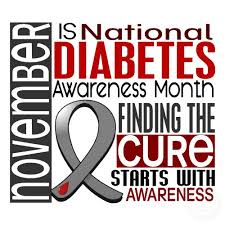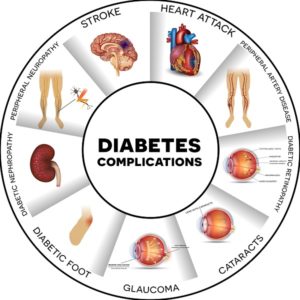Diabetes is becoming more common in the United States. From 1980 through 2011, the number of Americans with diagnosed diabetes has than tripled (from 5.6 million to 20.9 million).
DIABETES: The Signs & Symptom and How to control the them:
The signs and symptoms of Diabetes 1 or 2 with hyperglycemia (HIGH GLUCOSE LEVELS):
THINK OF THE 3 P’s=
1.)Polyuria-When all of sudden you are voiding urine. Poly ,meaning alot, uria, meaning urine,; so a lot of urinating due to your body trying to void out of the body excess glucose in your urine can be a symptom of diabetes. This is a common symptom that causes the next symptoms due to your voiding a lot of urine which causes your body to lose fluid, being water with alot of glucose in the urine, and in return you become very thirsty with hungry. This gives you:
2.)Polydipsia= very thirsty
3.)Polyphagia=very hungry
This should be a red light for a diabetic with these one or all 3 symptoms to finger stick or glucose test themselves. See where your glucose level is at and if over 200 this is why you have one or all of the “P” symptoms (listed above).
Other s/s of Diabetes consist of:
– Tingling / Numbness in the hands and feet (diabetic neuropathy)
-Very tired and fatigued
-Weight Loss (more common to see in Diabetes 1; most of the time Type II DM is due to obesity and noncompliance of a diabetic )
-Blurred Vision.
-Sores or diabetic ulcers especially in the lower extremities that do not heal; and if not healed, this can cause in time a severe condition.
Complications that can come about due to DIABETES:
Dental Disease – Diabetes can lead to problems with teeth and gums, called gingivitis and periodontitis.
Heart Disease – People with diabetes have a higher risk for HTN, heart attack and stroke.
Eye Complications – People with diabetes have a higher risk of blindness and other vision problems.
Kidney Disease – Diabetes can damage the kidneys and may lead all the way up to kidney failure.
Nerve Damage (neuropathy) – Diabetes can cause damage to the nerves that run through the body. Particularly neuropathy can occur leading to no feeling to other complications occuring (Example diabetic with neuropathy keeps stepping on sharp items not feeling them making a wound develop causing a sore not to heal that leads into a diabetic ulcer that doesn’t heel leading to a foot amputation or worse below or above knee amputation it leads to in time).
Foot Problems – Nerve damage, infections of the feet, and problems with blood flow to the feet can be caused by diabetes.
Skin Complications – Diabetes can cause skin problems, such as infections, sores, and itching. Skin problems are sometimes a first sign that someone has diabetes. Sores that cannot heal due to constant high glucose in the body can lead into a severe condition=AMPUTATION of the foot or leg.
**. (At least 15 % of all people with diabetes eventually have a foot ulcer, and 6 out of every 1000 people with Diabetes have an AMPUTATION. Possibly first surgery with bypassing the blood can resolve the problem 100% or like many only temporary. It is based on your other medical history with how brittle the diabetes and how compliant you are in taking care of yourself with diabetes. This is why you see with some diabetics amputations of the lower extremities, hardly ever a upper amputation which is usually due to trauma or smoking.***
All these complications are effected by hyperglycemia and in playing a part in the blood circulation of our body. Ending line the person is getting bad oxygenated blood supply sent to the lower extremities when the glucose is poorly controlled over a long time. Based on the principle of gravity; what happens here is the heart pumps our blood throughout our body and when it gets difficult for the organ to do its job due to thick high glucose blood than it has to compensate at some point. Simply a narrowing to a blockage is occurring in that lower extremity and the reason for this is it’s the furthest area from the heart=FEET/LEGS.
This can be caused by just thick high glucose blood flowing throughout the body making it difficult for the heart to pump as effectively as opposed to someone that doesn’t have hyperglycemia which over time leads to further complications (listed above).
Diabetes with constant high glucose blood levels can leaded into poor circulation causes the feet and lower leg to first become cool to cold to changing colors of pale to cyanotic (purple) which takes over weeks to months to years, depending on the patient. Then the tissue gets necrotic (black=dead tissue) and an amputation has to be done to save the person or else this will get infected locally, at first, going into a systemic infection causing the person to go into septicemia and expire.
REFERENCES for Part 1, Part 2 & 3:
1.) Center for Disease (CDC) – “National Diabetes Fact Sheet”
2.) NYS Dept. of Health –Diabetes
3.) Diabetic Neuropathy.org “All about diabetic neuropathy and nerve damage caused by Diabetes.”
4.) NIDDK “National Institute of Diabetes and Digestive and Kidney Diseases.
5.) National Diabetes Information Clearinghouse (NIDC) – U.S. Department of Health and Human Services. “Preventing Diabetes Problems: What you need to know”



